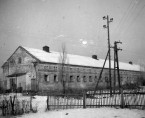Tschechowitz (II)
A sub-camp set up in the latter half of September 1944 on a farm near the railroad station at the Czechowice refinery (German: Tschechowitz-Vacuum). The first prisoners, almost 300 in number, were Jews from the Litzmannstadt ghetto. They were placed in a large brick stable and had three-tier bunks. Later, an adjoining washroom and storeroom were built. The square near the stables was surrounded by a chain-link fence. In October 305 more Jews, deported in transports from the Theresienstadt ghetto, were brought in.
The prisoners were employed dismantling factory buildings damaged during air raids; doing earth, bricklaying, and concrete work; building roads; and repairing railroad tracks. The director was an SS-man named Knoblik. Several SS guards were supported by factory guards, Organisation Todt members, and police.
There were 561 prisoners in the sub-camp at the moment of its evacuation. The majority of them were marched to Wodzisław Śląski and then taken by rail to Buchenwald. On January 21, 1945, the prisoners remaining in the sick bay were ordered to dig a deep hole nearby, ostensibly for burying the dead. Several hours later, SS men came in and shot all those unable to get out of their bunks. The remaining prisoners had to carry the bodies to the hole they had dug. They were ordered to cover the hole with straw mattresses, and when they stood at the edge they too were shot. The SS men poured gasoline on the pile of corpses and mattresses, and set it afire. A few prisoners managed to hide themselves in a nearby hen house and thus survived the massacre.
